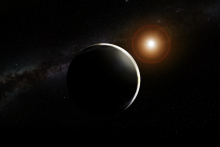Listen to today's episode of StarDate on the web the same day it airs in high-quality streaming audio without any extra ads or announcements. Choose a $8 one-month pass, or listen every day for a year for just $30.
You are here
South-Pole Astronomy
The south pole is high, dry, and cold. It sits about two miles high, and it gets only two or three inches of snow per year. The humidity is near zero, and the average temperature is more than 50 below. That makes it a tough place to live — but a great spot for studying the universe. Telescopes work best under high, dry skies, where there’s little air or water vapor to interfere with the view.
In fact, two major observatories operate at the south pole all year long. One of them looks up into the sky, while the other looks down through the solid Earth.
The South Pole Telescope watches the universe at radio wavelengths. Among other projects, it’s looking for evidence of dark energy. Dark energy appears to account for most of the “stuff” that makes up the universe. So far, though, scientists can’t explain it.
An observatory known as IceCube looks for evidence of neutrinos — particles that almost never interact with other forms of matter. They’re of interest because they’re produced by exploding stars and other powerful events.
IceCube consists of thousands of light detectors buried a mile deep in the ice. When a neutrino strikes a particle of other matter, it produces a flash of light. Neutrinos pass all the way through Earth, so IceCube uses the planet to screen out other signals.
Several scientists and engineers spend the long, dark winter at the pole to help keep these special “eyes” focused on the universe.
Script by Damond Benningfield





